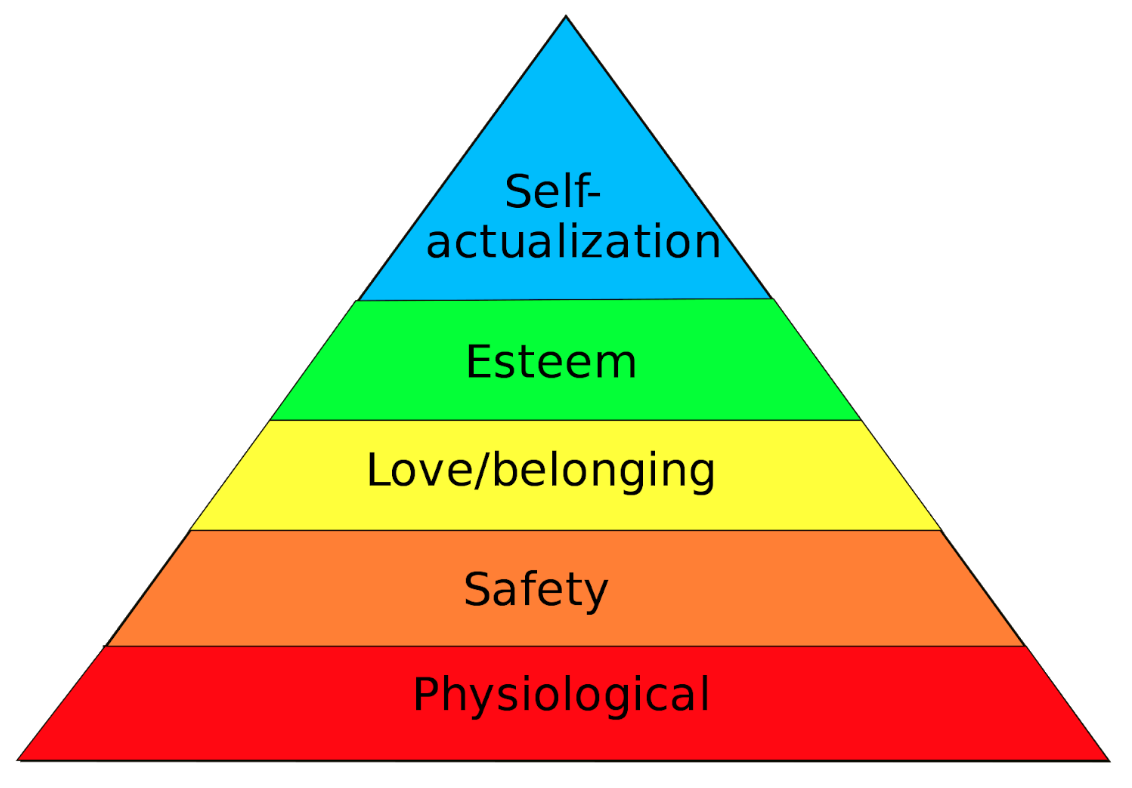1.6: Maslow's Hierarchy of Needs
- Page ID
- 48259
Maslow’s Hierarchy of Needs
- Nurses must continually organize patient data to be recorded, either written or electronically. One model for organizing and prioritizing patient care needs is Maslow's Hierarchy of Needs.
- Maslow’s hierarchy of needs is often portrayed in the shape of a pyramid, with the greatest and most fundamental levels of needs at the bottom, and the need for self-actualization at the top.
- Human needs, listed in order of importance by Maslow, are Physiological; Safety; Love and Belonging; Esteem; and Self-actualization.
- Maslow acknowledged that different levels are likely to be present at the same time. The hierarchy identifies the order of progression when needs are met.

Physiological Needs
Physiological needs are required for survival. If physiological are not met, the body cannot continue to function. The basic physiological needs are:
- Air
- Water
- Food
- Clothing
- Shelter
Safety Needs
Once physiological needs are met, individual safety takes precedence. Safety and Security needs include:
- Personal and family safety
- Financial security
- Health and well-being
Love/belonging Needs
After physiological and safety needs are fulfilled, the third layer of human needs are interpersonal. This involves feelings of belonging. Deficiencies in interpersonal needs, due to neglect, shunning, ostracism, etc., can impact an individual’s ability to form and maintain emotionally significant relationships in general, such as:
- Friendship
- Intimacy
- Family
Humans need to feel a sense of belonging and acceptance, whether it comes from larger community affiliations or simply a few close friends. Without these connections, many people become susceptible to loneliness, social anxiety, and clinical depression. This need for belonging can sometimes overcome physiological and security needs. For example, a person with anorexia may ignore the need to eat and the security of health for a feeling of control and belonging.
Esteem
Esteem represents the normal human desire to be accepted and valued by others. People need to engage themselves to gain recognition and have an activity or activities that give the person a sense of contribution, to feel self-valued, be it in a profession or hobby. Imbalances at this level can result in low self-esteem or an inferiority complex. Many people with low self-esteem will not be able to improve their view of themselves simply by receiving fame, respect, and glory externally, but must first accept themselves internally. Psychological imbalances, such as depression, can prevent one from obtaining self-esteem on both levels.
Self-actualization
This level of need refers to what a person’s full potential is and the realization of that potential. Maslow describes this level as the desire to accomplish everything that one can, to become the most that one can be. Individuals may perceive or focus on this need very specifically. For example, one individual may have the strong desire to become an ideal parent. In another, the desire may be expressed athletically. For others, it may be expressed in paintings, pictures, or inventions. Maslow believed that to acquire this level of need, the person must adequately achieve the previous needs.
Contributors and Attributions
CC Licensed Content, Shared Previously
- Maslow's Hierarchy of Needs. Authored by: Boundless. Located at: www.boundless.com/business/textbooks/boundless-business-textbook/motivation-theories-and-applications-11/theories-of-motivation-75/maslow-s-hierarchy-of-needs-356-3204/. License: CC BY-SA: Attribution-ShareAlike


